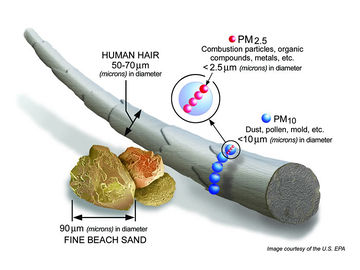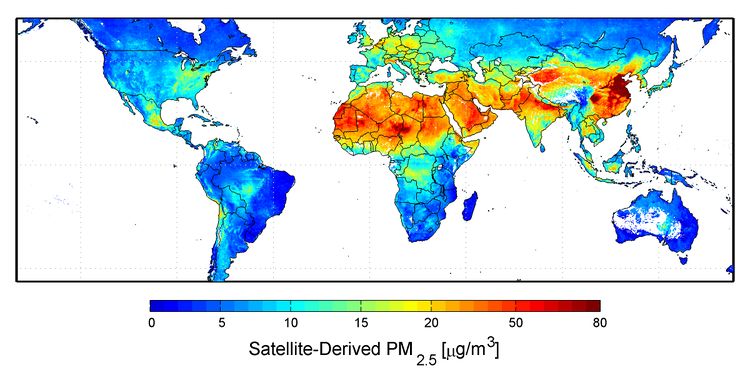Particulate matter

Particulate matter, sometimes called particle pollution or simply PM, is a term that refers to a mixture of solid particles and liquid droplets that can be found in the air. They are classified as pollutants and there are several different sizes of particulate matter. Some particulate matter, such as dust, dirt, soot, coal ash, and smoke are large enough to be seen with the naked eye. Particulate matter can also be extremely small, therefore, can only be seen with high-powered microscopes.[2] As well as containing acids, particulate matter can contain hazardous elements such as arsenic, beryllium, cadmium, chromium, lead, manganese, and nickel.[3].
Particulate matter can fall into several different categories depending on their size. These categories include inhalable coarse particles (PM10) that are between 2.5 and 10 micrometers in diameter and fine particles (PM2.5) with diameters of less than 2.5 micrometers.[2] In addition, particulate matter can be separated into 2 categories:
- primary particulate matter: PM that is emitted directly from sources such as power plants.
- secondary particulate matter: PM that is formed by chemical reactions in the atmosphere.[2]
Control Mechanisms
The energy sector does a good job of preventing the emissions of particulate matter. Most particulate matter in Canada comes from open sources like driving on unpaved roads, or construction work.
The removal of particulate matter from flue gases is generally the first step in cleaning these gases before they are released through the smokestacks. There are several different ways to remove this particulate matter from the gases, but there are three main types of separation used.
- Electrostatic precipitators filter out particulate matter from exhaust fumes by using static electricity. Unburned particles of carbon in the smoke are given a negative charge after passing through electrodes carrying a strong negative voltage. After this, they continue to float upwards until they reach a second electrode with a strong positive voltage. At this point, the particles carrying a charge are attracted to these electrodes and collected in a hopper.[4]
- Cyclone separators are devices that use the principle of inertia and the different sizes of particulate matter for removal. Here, dirty flue gas enters a chamber containing a vortex. In this vortex, gas particles have less inertia and move upwards while heavy particulate matter falls down and is collected.[5]
- Fabric filtration is the final method that can be used to remove particulate matter. This method simply uses some sort of fabric (generally felt) as a woven cloth which allows dust to make its way through to be collected in a hopper. In addition, flue gasses must pass through the fabric (which will filter the PM) before exiting the smokestacks.[6] When the gas passes through, dust particles are trapped in the cloth.
Side Effects
Particulate matter can cause significant health problems in humans—specifically, particles that are smaller than 10 micrometers. These particles are harmful as they can penetrate past a lung'a barrier defences and lodge themselves deep in the lungs. Chronic exposure to these particles increases the risk of developing cardiovascular and respiratory diseases as well as increasing the risk of developing lung cancer.[7] Exposure to particulate matter in high concentrations can even increase a persons risk of death as a result of some sort of respiratory failure. The elderly and young children are especially at risk for health problems, as well as anyone located in cities where smog is a problem. Figure 2 shows a map that indicates where PM2.5 particulate matter is an issue.

In addition to human health effects, particulate matter can harm the environment. The fact that particulate matter is a major component of smog means that it contributes to the blocking of natural sunlight that smog does. By limiting plants exposure to the Sun, their ability to take in carbon dioxide is limited, therefore, decreasing its photosynthetic capabilities. The chemical composition of the PM may also have an effect on the plants and their surrounding soil.[9]
Data Visualization
The following data visualization shows the sources emitting particulate matter in Canada. Note that the preset is for the larger PM10, but PM2.5 is also a selectable pollutant. It is important to note from the pie chart that a large amount of particulate matter doesn't arise from things related to energy production (much of it comes from driving on unpaved roads and construction, both of which use energy). Although coal ash makes up a portion of PM (and thus coal combustion is a source of PM), large sources include dust from construction and unpaved roads and mining operations.
For a more in-depth look at pollution data, including a graph showing how particulate matter emissions have changed over time, click here.
For Further Reading
- Pollutant
- Pollution
- Smog
- Electrostatic precipitator
- Cyclone separator
- Atmosphere
- Or explore a random page
References
- ↑ US EPA. (July 28, 2015). Particulate Matter Size Comparison [Online]. Available: http://www.epa.gov/pm/graphics/pm2_5_graphic_lg.jpg
- ↑ 2.0 2.1 2.2 US EPA. (July 27, 2015). Particulate Matter (PM) [Online]. Available: http://www.epa.gov/pm/basic.html
- ↑ Environmental Health & Engineering Inc., “Emissions of Hazardous Air Pollutants from Coal-fired Power Plants,” Needham, MA, 2011.
- ↑ Chris Woodford. (July 24, 2015). How Does an Electrostatic Precipitator Work? [Online]. Available: http://www.explainthatstuff.com/electrostaticsmokeprecipitators.html
- ↑ R. Wolfson. Energy, Environment and Climate, 2nd ed. New York, U.S.A.: Norton, 2012
- ↑ US EPA. (July 24, 2015). Air Pollution Control [Online]. Available: http://www.epa.gov/ttnchie1/conference/ei11/stationarysource/hochhauser.pdf
- ↑ WHO. (July 28, 2015). PM [Online]. Available: http://www.who.int/mediacentre/factsheets/fs313/en/
- ↑ NASA. (July 28, 2015). PM2.5 Map [Online]. Available: http://www.nasa.gov/topics/earth/features/health-sapping.html
- ↑ Prepared for Pollution Probe by Olivia Nugent. 2002. The Smog Primer.

